Module 7: Woodlot Ecology: Your Living Woodlot
 This module is intended to give you, the woodlot owner, an overview of the living systems that are present on your woodlot, and how these systems may be affected by the ways in which you manage your property.
This module is intended to give you, the woodlot owner, an overview of the living systems that are present on your woodlot, and how these systems may be affected by the ways in which you manage your property.
We will look at the components of living systems, from large groups of trees to the activity of microscopic soil organisms. We will examine how they interact and compete with one another for food, moisture and light. Finally we will look at ways that you, as a forest owner, can manage your land through holistic approaches that consider both scientific factors and human values.
Managing for multiple values on a small woodlot can be a daunting challenge. But it is essential to learn these management skills as timber values rub shoulders with other uses such as wildlife, recreation and aesthetics.
The author would like to thank the following individuals for their suggestions, comments and support during the compilation of this module: Simon Mutabazi, NSDNR Extension Forester; Tim Whynot, Manager, NSDNR Stewardship and Outreach; Bruce Carter, NSDNR Private Land Forester; Eugene Quigley, NSDNR Forest Technician; Emily Gratton, Manager, NSDNR Publications and Communications; Kevin Keys, NSDNR Forester, Tim McGrath, NSDNR Forester, Ian Millar, Executive Director, RPFANS and Martha Grantham, Supervisor of the Natural Resources Education Centre.
No acknowledgements would be complete without thanking Anne Comozzi, who drafted the first Module 7, titled Woodlot Ecology, in 1992.
Lesson One - An Introduction To Life On Your Woodlot
Your woodlot is an amazing place. It contains a rich mixture of many forms of life – from tiny animals in the soil, to towering trees, and other plants and animals that make up the forests of Nova Scotia.
The forest is a complex web of life. Everything that lives in the forest interacts with other components, and life and death are everywhere. Your woodlot is a small part of a much larger forest that extends throughout Nova Scotia, across Canada and around the world.
Understanding the basic flow of energy in nature, and how the cycling of nutrients occurs on your woodlot is important to making the best decisions possible for managing your woodlot.
 |
|
Figure 2 - Forests have many unusual forms of life, like this coral mushroom.
|
Forests mean different things to different people. To some, forests are places to enjoy peace and quiet. To others, forests are sources of work and income. These uses – or values – are important in planning the overall management of forests in Nova Scotia.
What is Forest Ecology?
In simple terms, ecology is the interaction of living things with their environment. The word ecology is derived from the Greek word ekos, meaning household. A forest can be thought of as a household of trees, plants, animals and other living things growing together. These interactions can exist on several scales. For example, bacteria living in the soil have direct effects on the surrounding soil and on other organisms living near it. In return, the soil and other living things in the soil, have direct and indirect effects on the bacteria. This all happens on a small, local scale.
At a larger scale, a tree on your woodlot has many interactions with organisms that live around and within it. For example, insects live on and in the tree, as do bacteria, fungi, and birds and mammals. The tree draws its nourishment from the air, the sun and the soil, and provides food to these organisms. It releases oxygen into the air and interacts with soil organisms that live around its roots.
A community of plants and animals that associate with their environment and with one another is called an ecosystem. Ecosystems can be very complex, and involve cycles and processes which include both living and non-living things.
Why is knowledge of ecology important?
It is important that people understand ecology and ecosystems, since humans are very much part of the Earth’s web of life. Nearly everything that we do impacts local ecosystems and may also affect ecosystems on a much larger scale. As we gain knowledge of the world around us, we can change the way we live to lessen the impacts on our environment. For example, we learned that pesticides like DDT were accumulating in the environment, harming predatory birds such as eagles and ospreys. By eliminating the use of these chemicals, populations of these raptors have rebounded to healthy levels.
 |
|
Figure 3 -are composed of living things interacting with their environment.
|
The human population is expanding rapidly. To put this into context, during the time it takes for a tree to mature in Nova Scotia (60 – 80 years), the world population of humans may increase by 4 billion people. That’s a 50 percent increase in the population of one species. In ecological terms, most species grow at the expense of other species. What other species are we affecting?
The more that humans understand the environment and our relationship with the living and non-living world around us (including forests and woodlots), the better chance we have of preventing damage to cycles and processes that are essential to life on Earth.
Woodlot owners can have a dramatic influence on the health and diversity of Nova Scotia’s forests, since more than half of the province’s forests are owned by private non-industrial owners. With over 50,000 woodlots under the private ownership of more than 30,000 woodlot owners, how woodlot owners manage their forests is the single most important contributor to the health of forest ecosystems.
THE FOREST OF THE ACADIAN ECOZONE
 |
|
|
Figure 4 -Old Acadian Forest in western Nova Scotia.
|
|
The Acadian Ecozone is a broad region of vegetation that includes most of Canada’s Maritime Provinces
– Nova Scotia (NS), New Brunswick (NB), and Prince Edward Island (PE). The entire land mass of Nova Scotia is located within the Acadian Ecozone. The forest of this area is often referred to as the Acadian Forest. It is formed from the interweaving of the conifer-dominated boreal forest to the north and the northern hardwood forest to the south. Here, the boreal forest tree species of white and black spruce, jack pine, balsam fir and white birch mix with sugar maples and red oaks. White pine and eastern hemlock are also characteristic of this transition zone. The tree species most associated with the Acadian Forest is Nova Scotia’s provincial tree, the red spruce.
During the last ice age, glaciers covered Nova Scotia and much of the northern hemisphere. As the glaciers retreated northwards some 10,000 years ago, they scraped the surface of the landscape, creating new drainage patterns and mixing soils and rock. Depressions filled with water and became rivers and lakes.
As the climate warmed, the newly exposed landscape of Nova Scotia became covered with spruce, fir and birch. Parts of the province still exhibit these post-glacial forests. Over time, other tree species became established over much of the landscape and formed what is today known as the Acadian Forest. This diverse forest resulted from the unique topography left by the glaciers, and from the moderate temperatures and weather conditions created by the mixing of northern and southern climates. Many of the birds, mammals, fish, reptiles, amphibians and insects we recognize today also became established at this time.
Forests are complex places, with interconnecting ecosystems that are composed of many species living in a multitude of environments. Managing forest ecosystems can be a challenging task, particularly when economic, social and environmental values must be considered. Developing effective ecosystem-based management tools is essential to ensure that environmental approaches are used when managing woodlots.
Some of the most important tools in managing ecosystems are maps. Visually, maps can assist woodlot owners in planning forest operations such as building woodlot roads and forest harvesting. The Province of Nova Scotia has developed a set of Ecological Land Classification maps that are based on physical features such as climate, topography, soil drainage and texture.
Climate
 |
|
|
Figure 5 -Forest Ecoregion and Ecodistrict Classi?cation map of Nova Scotia (NSDNR). |
|
The development of the forests of Nova Scotia is the result of many interactions, including climate, site and soils. Located on the eastern coast of North America in a maritime region that receives some of the highest precipitation in Canada, Nova Scotia has a relatively short and late growing season.
Within Nova Scotia are several climatic zones, which differ from each other in number of growing days per year, the amount of precipitation and the elevation of the land. The distribution of these zones is often directly related to their distance from the coast.
Variations in climate can occur on a small scale, and are related to a woodlot’s topography and forest structure. These compact areas of distinct climates are called microclimates. Because of microclimate, frost damage can occur to plants in depressions, while sunscald can affect plants in exposed areas. Microclimate can have direct impacts on species population growth in ecosystems.
In forests, climate, site and soils can have direct impacts on the health and productivity of living systems both above and below the surface of the ground. All life needs sunlight, air, water and a suitable temperature in which to live.
SUNLIGHT
Solar energy is required by all plants to manufacture food through photosynthesis. In the forest, not all trees and other plants grow in direct sunlight – these have become adapted to growing in the shade. Trees that require full sunlight for growth include trembling aspen, larch and white birch. On the other hand, species like eastern hemlock and yellow birch can thrive in the shade.
 |
|
|
Figure 6 -Tamarack needs full sunlight for optimum growth. |
|
Perennial plants, such as trees, are sensitive to photoperiod, or hours of sunlight during the day. As the photoperiod shortens during late summer, trees begin to enter dormancy in preparation for the winter months ahead. During this time, their leaves may change colour. Insects prepare for winter by seeking shelter in the forest soil or under the bark of trees. Some bird species migrate south, while others such as blue jays, respond to the shorter days by storing acorns and other seeds. Amphibians, like leopard frogs, bury themselves in the mud at the bottoms of ponds, while some mammals prepare to hibernate to conserve energy.
WIND
The movement of air through a forest ecosystem is an important contributor to the natural processes that drive ecosystems. As we will discuss in later chapters, the water cycle is an essential part of every living system. Air assists in evaporation and the movement of water from one place to another. It also helps the movement of atmospheric gases such as oxygen and carbon dioxide, and is responsible for weather patterns that are mixtures of cold and warm air.
Wind can help distribute seeds from one place to another, and assists in pollinating flowering plants. In a coastal region like Nova Scotia, there is almost always wind. The prevailing winds are from the southwest, which can bring airborne pollutants and, during storms, non-resident birds like turkey vultures.
 |
|
|
Figure 7 -Wind-throw is the most common natural disturbance in Nova Scotia forests. |
|
Air movement can also cause damage to forests, as when strong winds uproot trees and break treetops. Small-scale wind disturbances occur frequently in Nova Scotia, and occasionally a major wind event like a hurricane will cause extensive damage. Some tree species like oak and white pine are able to withstand higher winds because of their deep rooting characteristics, while other tree species such as spruce and aspen are more likely to be uprooted or suffer stem breakage.
All plants use air in respiration, as oxygen is used and carbon dioxide, water and energy is released.
PRECIPITATION
In areas of precipitation, water cycles through ecosystems and provides all living organisms with enough water to live and function. Trees and other plants receive water from both the atmosphere and the soil. Precipitation can occur in the form of rain, snow or fog. In general, Nova Scotia’s coastal areas are higher in humidity than farther inland due to the presence of fog.
Temperature
Forests are important moderators of temperature. As the Earth absorbs heat during the day in the form of solar radiation, forest canopies help to reflect radiation back into the atmosphere, keeping the forest floor cool. During the night, forest canopies help prevent heat from escaping the forest floor, moderating the temperature in forest ecosystems.
 |
|
|
Figure 8 -Water shapes landscapes and provides the basis for life. |
|
Excessive cold can damage plant stems and leaves, while too much heat can cause wilting from moisture loss. Trees like spruce and fir have waxy coatings on the surface of their needles which help prevent this. While animals can move around to escape extremes of heat or cold, mammal species in the Acadian Forest have adapted to temperature changes by growing heavier coats of fur or hair during winter, or by seeking shelter in dens. During periods of hot weather, the respiration of animals increases, releasing moisture. Unless the moisture is replenished by drinking water, most animals cannot tolerate high temperatures for long periods before too much water is lost.
Temperatures that are too warm or too cold for extended periods cause stress within ecosystems. When climate changes, many species are unable to adapt and are replaced by other species that are better suited to the climatic conditions.
 |
|
|
Figure 9 -Forest vegetation helps keep the forest floor cool. |
|
Module 7 - Lesson One Quiz
| Questions: | 10 |
| Attempts allowed: | Unlimited |
| Available: | Always |
| Pass rate: | 75 % |
| Backwards navigation: | Allowed |
Lesson Two - Cycles Of Life
We are familiar with the term “recycling” as it relates to re-using household waste and items we no longer need. Recycling also takes place in nature as compounds are broken down and re-assembled into other compounds.
Both energy and materials flow through ecosystems. It would be impossible for life to continue without the continual replenishment of nutrients. The quantities of nutrients and energy available to ecosystems directly affect the populations of organisms, the metabolic rate at which they live and the structure of the ecosystem.
The flow of nutrients and energy through an ecosystem depends on a positive feedback loop: the greater the supply of nutrients, the more energy will be produced. As more energy flows through a system, more nutrients are released for productivity. However, productivity cannot expand indefinitely.
 |
|
|
Figure 10 -An example of a food chain in a Nova Scotia woodlot. |
|
There is a point beyond which the requirement for nutrients and energy is so great that further growth is limited.
The food chain on your woodlot starts with plants that absorb solar energy and use it to produce sugars. The plants either decay and are broken down by bacteria or fungi, or are consumed by herbivores (plant-eaters). The consumers are preyed upon by carnivores, which may in turn be eaten by other carnivores.
Nutrient Flow in Ecosystems
The rate of movement of nutrients through a forest ecosystem depends on several factors, including:
-The quantity of available nutrients
-The rate of decomposition of organic matter for nutrients
Nutrients are found everywhere on your woodlot. Trees and other vegetation store vast quantities of nutrients that are recycled into the soil when the leaves fall off in autumn, or when trees are blown down. When trees are harvested, the stumps, branches and leaves that are left behind decompose and the nutrients accumulate in the soil until they are used by other producers.
Large quantities of nutrients are stored in forest soils, and in decaying woody material on the forest floor. While these nutrients may not be immediately available to other producers, decomposer organisms can release them.
Many elements essential to living ecosystems are stored in the trees and other vegetation of your woodlot. These include nitrogen, phosphorus, potassium, calcium and magnesium.
Hardwood trees contribute more nutrients to the environment than softwoods because their leaves and twigs break down more quickly. If you have a diverse mixture of hardwood and softwood trees on through the soil and are made available to plants your woodlot, nutrients are constantly being cycled and animals.
 |
|
|
Figure 11 - Nutrient flow in a forest ecosystem. |
|
More than Moisture: The Water Cycle
A high proportion of living things is made up of water. Plants need water to make food and to move nutrients through their systems. Over three-quarters of most animals' body weight is water.
Solar energy and rain are the driving forces of the water cycle. Precipitation is the primary means by which water in the atmosphere reaches the Earth, and solar energy causes water to be recycled from the oceans, rivers, streams and lakes. The warm, moist air rises and forms clouds of water vapor. Wind moves the clouds over the land where some of the water falls as snow or rain. Fog may also form, which can be important in maintaining moisture on or near the ground.
Water is often intercepted before it reaches the ground. Trees and other vegetation absorb moisture through the leaves: hardwoods intercept precipitation during a light summer rain. In winter, softwoods intercept a higher proportion of precipitation than hardwoods.
During growing season, water is taken up by plant roots and used to manufacture sugar in the leaves of the plant. By a process called evapotranspiration, plants gradually release water back into the air. This control mechanism allows plants to retain water when it is dry, and release it at other times. As plants take up water through their roots and move it to their leaves, some water is lost. This occurs when water leaks from the leaves as they open the pores in the leaves called stomata to receive carbon dioxide from the atmosphere. Once trees are saturated, excessive moisture will drip from their leaves, needles and branches, or run down the tree's stem.
Water enters the soil through infiltration. The rate that it enters the soil depends on the topography of the site, vegetation cover and the soil's physical characteristics. Water fills pores in the soil through gravity and capillary action until the capacity of the soil is reached. By a process called percolation, water moves downwards through the soil until it reaches an impervious layer. It may collect here or move to springs and streams.
 |
|
|
Figure 12 - Beaver meadows are important sources of water and nutrients to many species of wildlife. |
|
In some finely textured soils, water is held tightly to soil particles. These soils may appear saturated at nearly all times of the year. The ability of soils to hold water is called its field capacity. Soils with high clay content have a high field capacity, while sandy, well-drained soils have a low field capacity.
Water that remains on the surface of the soil, in streams and rivers, or on the leaves of plants, returns to the atmosphere by evaporation.
 |
|
|
Figure 13 - The Water Cycle. |
|
The Stuff of Life:The Carbon Cycle
All organic compounds contain carbon, which plays a vital role in the production of oxygen and sugars by plants, a process called photosynthesis. Carbon is found in both living and dead organisms, including fossils.
During photosynthesis, plants absorb carbon dioxide from the atmosphere and use it to manufacture sugars and fats, and is stored as plant tissue. Herbivores, or plant-eating animals, convert the plant tissue to other forms of carbon-based compounds. Meat-eating Carnivores consume herbivores, and the carbon is re-digested and re-formed into other organic compounds. Respiration by plants and animals also return carbon dioxide to the atmosphere.
Decomposing organisms release carbon dioxide as plant and animal wastes and tissues are broken down. In wet areas such as marshes and bogs, with little available oxygen to aid the decomposition process, organic carbon is broken down very slowly and may be stored as peat.
Over many years, carbon can also be stored as coal, oil and natural gas. During the past century, an important source of carbon in the atmosphere has been the burning of fossil fuels, which releases long-held carbon in the form of carbon dioxide and methane.
 |
|
|
Figure 13a - The Carbon Cycle. |
|
The concentration of carbon in the atmosphere varies during the day. In early morning, as plants begin photosynthesis, the concentration of carbon dioxide drops sharply until the afternoon when plants slow their uptake of carbon dioxide as sunlight decreases. During winter months in temperate climates, plants assimilate less carbon dioxide than in summer months, resulting in higher carbon dioxide levels in the atmosphere during this time.
Forests store carbon longer than other ecosystems. During forest fires or when wood is burned for fuel or land-clearing, carbon is released quickly. When logging slash decomposes, carbon is released slowly.
Fertilizer of the Forest: The Nitrogen Cycle
The atmosphere is composed of 79 percent nitrogen and is an essential component of protein, making it fundamental to all living things. In its gaseous state, however, nitrogen cannot be used by most forms of life. It must be converted to other compounds in order to be made available to plants and animals.
Three processes convert nitrogen into useable forms:
-
Fixation
-
Ammonification
-
Nitrification
Fixation: There are two ways in which nitrogen can be made available to living things: by conversion to nitrates through high-energy fixation, or by conversion to ammonia through biological processes. High-energy fixation can be achieved by lightning in the atmosphere, and nitrates are carried to Earth by precipitation.
 |
|
|
Figure 13a - Alders "fix" nitrogen and make it available to other plants. |
|
Over 90 percent of fixation is carried out by bacteria working in symbiosis with plants. During fixation, gaseous nitrogen is converted to ammonia in chemical reactions, occurring near the roots of the plants, which may be legumes (pea family), or non-legumes with nodule-bearing roots (speckled alder is a good example).
Ammonification: Dead animal and plant tissues are broken down by decomposing organisms in soil and water. The amino acids that are generated by this process are further decomposed by bacteria to yield carbon dioxide, water and ammonia. Soluble in water, the ammonia is available for uptake by plant roots.
Nitrification: In this process, ammonia is converted to nitrates and nitrites by micro-organisms. However, nitrates in larger quantities can be harmful to the environment, and its ready solubility in water can move the nitrates away from plant roots before they are absorbed. During denitrification, nitrates in the presence of fungi and some bacteria are broken down into gaseous nitrogen, which is released into the atmosphere for the process to begin again.
Nitrogen in the form of ammonia or nitrates is taken up by plants and converted to amino acids when plants are eaten by herbivores. As plant and animal tissues decay, they are broken down by bacteria and fungi to form ammonia. The ammonia can either be taken up by plants to be converted into amino acids, or undergo denitrification to be released as gaseous nitrogen. Nitrates resulting from nitrification can be taken up by plants, trapped in decomposing organic material, stored by microbes, or leached away by water to aquatic marine environments, where the cycle will continue.
NITROGEN-FIXING BACTERIA
Without nitrogen, many forms of life would not exist. Although the atmosphere contains 79 percent nitrogen, in its gaseous form it cannot be used by plants and animals. Specialized bacteria are able to "fix" nitrogen, combining nitrogen with hydrogen to form ammonia. Because ammonia is soluble in water, plants can take it up and use it for growth and other processes.
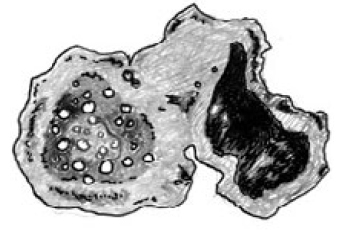 |
|
|
Figure 15 - A cross-section of a root with a nodule containing nitrogen-fixing bacteria. |
|
Large amounts of nitrogen are lost when forests are harvested and woody material is removed from the site. In the absence of nitrates, soil nutrition is depleted until new regeneration is established on the forest floor. Only about 1 to 3 percent of soil organic matter is nitrogen, but this small amount is used over and over again.
 |
|
|
Figure 16 - Clearcutting removes significant amounts of useable nitrogen from forest soils. |
|
Nitrogen can be released into the environment in harmful forms such as nitrogen oxides. Common in automobile exhaust and industrial emissions, nitrogen oxides are broken down by ultraviolet light into nitrogen monoxide and atomic oxygen. Atomic oxygen reacts with molecular oxygen to form ozone, which multiplies the harmful effects of many other types of air pollutants.
The Good, the Bad and the Smelly: The Sulfur Cycle
Sulfur occurs naturally in rocks, sediments and in the Earth's atmosphere. It enters the atmosphere through the decomposition of plant and animal tissue and by volcanic eruptions. Sulfur is present in the atmosphere in the form of hydrogen sulfide and sulfur dioxide. Precipitation carries the sulfur back to Earth, and its reaction with water results in the formation of sulfuric acid. In this soluble state, sulfur is taken up by plants where it plays a vital role in photosynthesis and in building protein.
Sulfur is returned to the environment as plants (or herbivores that have consumed the plants) decay or excrete sulfur into the soil or water. Sulfur accumulates at the bottoms of ponds and oceans, where bacterial activity releases it as hydrogen sulfide or sulfate. You've likely noticed the smell of sulfur near swamps and salt marshes, where sulfuric acid persists in the mud.
 |
|
|
Figure 17 - High sulfur content in the atmosphere causes acid rain and acidic lakes and streams. |
|
Humans release sulfuric acid and sulfur dioxide into the atmosphere by burning fossil fuels. Over time, sulfuric acid accumulates in soils and water and can harm plants, fish and other organisms.
Acid rain, caused by high sulfur emissions, has been a severe problem in forests and lakes of southwestern Nova Scotia during the past few decades. This has been primarily caused by the burning of fossil fuels. With improved technologies and reductions in hydrogen sulfide emissions, much of this area of the province has begun to recover.
An Essential Element: The Phosphorus Cycle
Living things require phosphorus for the formation of cell membranes, the construction of DNA, and in the structure of bones and teeth. While sulfur is commonly found in the atmosphere, phosphorus is not. Phosphorus follows only terrestrial or aquatic cycles, which limits the ways in which it can be distributed.
Weathering of phosphate deposits in rock is the most common source of phosphorus in the environment. Phosphorus finds its way through ecosystems by uptake and release by plants, ingestion and excretion by animals, and by decay. It accumulates in soils and is stored in sedimentary rock until weathering releases it.
Phosphorus is a major component of agricultural fertilizers, and concentrations in water results in algae "blooms" as organisms react to the phosphorus-rich environment. Plankton are microcopic organisms that life suspended in the water. Zooplankton are animal plankton that ingest the phosphorus and excrete much of it as inorganic phosphates. These wastes are taken up by phytoplankton (plant plankton) and bacteria, which are consumed by other organisms. Decaying plants and animals settle on the bottom, and phosphorus is recycled as sediments are exposed and weathered.
 |
|
|
Figure 18 - Phosphorus is recycled through the soil and water and is rarely found in the atmosphere |
|
Module 7 - Lesson Two Quiz
| Questions: | 5 |
| Attempts allowed: | Unlimited |
| Available: | Always |
| Pass rate: | 75 % |
| Backwards navigation: | Allowed |
Lesson Three - Forest Ecosystems
Think of the community in which you live. Most likely, individuals, and groups of individuals, interact with each other and with the environment around them. Forest ecosystems are similar, with single organisms - or groups of them - interacting with other organisms and adapting to the environment in which they live.
Forest ecosystems might exist in a pool of water, on the bark of a tree or under a decaying log. Many of the organisms may be microscopic. Other ecosystems may contain organisms as large as trees and encompass several hectares of forest. In both cases, individuals have adapted to their environment and to each other.
 |
|
|
Figure 19 - Ecosystems come in all sizes and shapes. These decay-ing logs support whole ecosystems of species. |
|
The place or role that individuals or groups occupy in an ecosystem is called a niche. These roles are essential to ensure the proper functioning of the ecosystem.
When we think of forest ecosystems, we often think of wildlife. Small mammals like moles, shrews, and chipmunks loosen the soil and move decomposing material when they tunnel and burrow. Forest floor litter eaten by these animals passes through their digestive systems where it meets new chemicals which help break down material.
Many different wildlife species depend on each other. Aphids and ants often live and work together. Ants protect the aphids and in return receive a food supply of "honeydew" from the aphids. Bacteria living in the stomach of deer depend on the deer's stomach for warmth and the deer need the bacteria to digest food.
Insects are important members of forest ecosystems. They pollinate plants, feed on waste, provide a food source for other animals, and also eat other insects. Some insects feed on trees but these are a very small part of the forest insect community. In Nova Scotia some 10,000 species of insects live in our forests.
An edge is created where one ecosystem meets another. This may be where a forested area meets a watercourse or it may be a place where two different communities of plants or trees meet. For example, an edge is created where a spruce stand meets an open field. Edges can also be man made
-for example, where a harvested forest meets an uncut forest. The size and shape of the forest cut determines the amount of edge.
Generally, edges are very important for wildlife because they offer more choices for food, water, cover, and space requirements. The areas in which wildlife can find these necessities of life are called habitat. Near edges, wildlife has simultaneous access to both kinds of habitat, and can quickly move away if necessary. As a result, wildlife is often more numerous near edge areas of a woodlot.
 |
|
|
Figure 20 - Edges are where two types of wildlife habitats meet. |
|
Not all species in an ecosystem are equally dominant. In an ecosystem of many hundreds, only a few species exert a controlling influence over the rest of the ecosystem. The dominant species are those that are most successful and which influence the presence of other kinds of plants and animals. For example, the kinds of plants that grow on the forest floor are determined in part by the trees. Small plants, like mayflowers or dogtooth violets, flower early in spring when the maple leaves are just budding and there is little shade. In spruce and fir-dominated forests where shade is considerable, plants which require less light will grow.
Differences between terrestrial ecosystems are most easily determined by observing the types of vegetation occupying a forest site. A community is composed of common groups of vegetation that normally occur together. Sample communities of trees in Nova Scotia include spruce and balsam fir, spruce and white pine, and yellow birch and red maple. Even communities that have much in common can have differences because the forest is always changing or being disturbed, or the soil or climate may vary. These factors alter the growth pattern of forest stands so that one group of balsam fir and spruce may be slightly different from another or vary from one woodlot to the next.
Succession
The change in species and community structure over time is called succession. Examples of succession are easy to identify: the return of abandoned farmland to forest is a good example.
Abandoned agricultural land goes through a fairly predictable process of succession. Herbs and shrubs like goldenrod, speckled alder (which fixes nitrogen) and meadow-sweet become established on old fields within a few years of abandonment. White spruce, tamarack and trembling aspen may follow shortly afterward, depending on the soil moisture content and available nutrients. The old fields are transformed, over 20 or 30 years, into a young forest.
 |
|
|
Figure 21 - Old fields go through predictable stages of succession. This is a common sight throughout Nova Scotia. |
|
Succession can also occur on harvested forest sites, or clearcuts. These areas have had most or all of the trees removed. Over time, most of these sites will regenerate to a new forest.
 |
|
|
Figure 22 -Most clearcuts will regenerate with Acadian Forest tree species. |
|
Succession in harvested forest areas results in more complex communities of trees, shrubs and herbs than on old fields.
Forested sites that are not harvested are often impacted by natural disturbances such as wind, fire and insect outbreaks. In the past, the forests of Nova Scotia were constantly changing as these natural forces created gaps in the forest. Many of these gaps were fairly small as individual trees blew down, or were quite large as fire swept through hundreds of hectares of forest. These sites are examples of succession.
 |
|
|
Figure 23 -This forest stand has been killed by a white-marked tussock moth outbreak, and has begun to regenerate. |
|
As seen by these examples, succession brings about changes in the diversity of ecosystems: they usually become more complex over time, until they reach a climax state that changes very little over time. In forests, an example of a climax ecosystem is an old-growth forest.
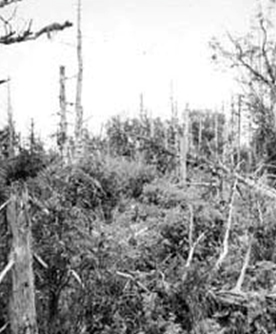 |
|
|
Figure 23 -Old growth forests are stable ecosystems. |
|
Balsam fir forests can also exhibit stability, with regeneration succeeding over-mature and dying fir. This forest type is continually renewing itself. Spruce budworm outbreaks are periodic, recurring at 35- to 40-year intervals, and are part of the natural cycle of events associated with the maturing of balsam fir. Human interaction, too, allows for natural regeneration of the balsam fir forest, by harvesting trees when they are mature. Such disturbances can maintain the stability of forest ecosystems.
In Nova Scotia, succession in most natural forest ecosystems is interrupted by disturbances such as wind, insect outbreaks and tree harvesting. More than 200 years ago, fire likely played a larger role in defining forest communities than it does today. With prompt and effective modern fire suppression, fires are less important today in shaping forest ecosystems. As a result some fire-dependent ecosystems may become less common as time goes by.
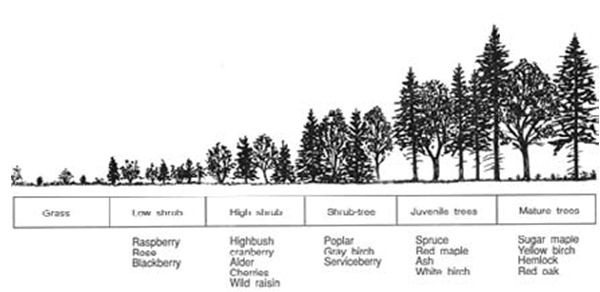 |
|
|
Figure 24a -Changes in the forest: successional stages. |
|
Classifying Forest Ecosystems
Forest Ecosystem Classification is a useful tool that lets you identify vegetation types, soil types and ecositess on your woodlot. Forest Ecosystem Classification is based in the identification of ecosites by considering the soil types and vegetation structure of your woodlot. Ecosites are groups of communities which have developed under similar moisture and nutrient conditions. In forests, moisture and nutrients are two important controlling factors in the growth of trees and other vegetation. Similar ecosites may be found over a wide geographic area.
 |
|
|
Figure 25 -Nova Scotia's new Forest Ecosystem Classification guide. |
|
In forests, trees are the most obvious forms of vegetation. Vegetation types are identified by observing the tree species and the shrubs and other plants that live there.
At a landscape level, ecosystem classification can be used as a tool for landscape planning which can then be ecologically linked to forest operations and stand-level planning. NSDNR has already produced a comprehensive ecological landscape classification (ELC) system for Nova Scotia. This system begins with ecozone and moves through ecoregions, ecodistricts, ecosections, and finally ecosites - the level where the ELC and Forest Ecosystem Classification systems converge.
At a stand level, classifying forest ecosystems based on vegetation, soil, and site conditions allows forest professionals to recognize similar ecosystem units on the ground and to develop a common understanding of these units. This allows for further development of guidelines and best management practices, and leads to more predictable and sustainable forest management.
Vegetation Types are recurring and identifiable forest plant communities which re?ect differences in site conditions, disturbances, and succession.
Soil Types are soils that can be identified by texture, drainage, fertility, and depth, all of which in?uence site productivity.
Ecosites are units which represent ecosystems that have developed under a variety of conditions and in?uences, but which have similar moisture and nutrient regimes. An ecosite is associated with a range of soil and site conditions and a range of vegetation types that grow naturally under those conditions.
 |
|
|
Figure 26 -There are more than 80 different forest vegetation types identified in Nova Scotia, including this Red oak-White pine/teaberry type. |
|
Many different vegetation types exist in Nova Scotia, and these have been classified according to their moisture regimes and availability of nutrients by the Nova Scotia Department of Natural Resources. By classifying forest ecosystems based on vegetation, soil and site attributes, woodlot owners and others can learn to recognize ecosystems and have a better understanding of the ways in which those ecosystems function. It also helps them predict which woodlot management treatments will work best on particular sites.
Module 7 - Lesson Three Quiz
| Questions: | 10 |
| Attempts allowed: | Unlimited |
| Available: | Always |
| Pass rate: | 75 % |
| Backwards navigation: | Allowed |
Lesson Four - Growth and Change On Your Woodlot
Your woodlot is constantly changing, although the changes seem small. Even over a period of several years it may be difficult to see much difference, even in the growth of trees and shrubs. But growth is occurring, and most of it is hidden beneath the soil surface where roots are constantly searching for new opportunities. Tree crowns also expand if space is available in the forest canopy, and as new leaves are developed, the diameter and height of the tree increases.
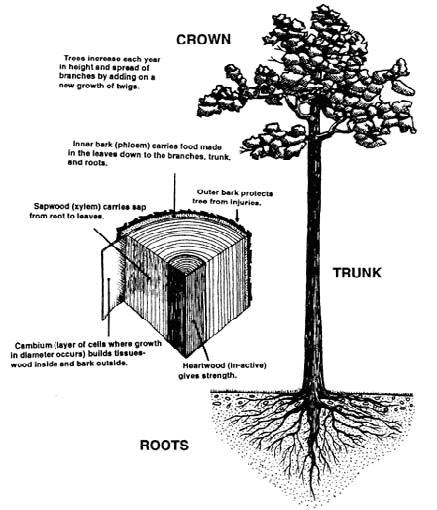 |
|
Figure 26a: Growth is reflcted in the crown, stem and roots of a tree. |
Tree and Plant Structure
Roots are like underground branches: they provide nutrients and water, and anchor plants. The roots are where material is collected for use in food production, and are the primary connectors to all the natural cycles in the woodlot.
As the plant grows new leaves or branches, new roots grow underground. In trees, surface roots extend near the top of the soil and will spread at least as wide as the widest part of the branches and leaves which form the tree's crown. Most roots are part of a dense network of feeding roots that move through the top layers of the soil. The type of tree, type of soil, amount of available water, and the number of other plants growing nearby all affect the size and shape of the tree.
The trunk or stem of a tree or a plant provides support and has an amazing array of vertical tubes called xylem and phloem that pass sap, water, and food from one part of the tree to another.
The bark's function is to protect the tree during all seasons of the year. The bark of a birch tree is only about 0.64 cm thick, while the bark of an eastern hemlock may be more than 5 cm thick. The inner bark is soft and moist and is used to transport sugar from the leaves to the roots. The outer bark, which thickens as the tree matures, is usually harder and protects the tree from temperature changes, insects, and diseases.
The thin layer of cells that is the growing part of the tree is called the cambium, and is sandwiched between the bark and the wood. The new layer of wood added to a tree each year appears as a ring in the tree stump. The number of rings can tell us how old a tree is, and the distances between the rings tell us what the growing conditions were like in the past. Tree rings are divided into early wood - the light wood between the dark rings, and late wood - the dark wood laid down as the tree's growth slows in late summer.
Many people try to guess the age of a tree by looking at the diameter of the trunk. Yet there are many small spindly trees that are old. Usually these trees have not had enough space, light or nutrients to grow. For example, black spruce trees that grow in wet soils become stunted, and trees that grow on barrens are smaller because they don't have enough nutrients.
A tree's growth rings can also tell us information about climate, pollution, insects, wind, fires and other influences on a tree's life. The study of tree rings is called dendrochronology. Droughts may limit the width of a tree ring and insects and pollution will leave telltale bumps and markings. Fires will leave scars in the rings of surviving trees, and the wind can cause a tree to lean, resulting in compressed rings on one side. Each tree owes its appearance to the environment in which it has grown.
Reproduction in Trees and Plants
In trees, flowers are necessary for reproduction. Many people are surprised that trees have flowers. The black spruce has small reddish cone-like flowers that may be hard to notice because they are near the top of the tree. These flowers depend on the wind for pollination so they do not have to attract insects. The flowers of an apple tree and smaller plants depend largely on insects for pollination, and they must be large and fragrant to attract the insects.
A tree is ready to reproduce when it can produce flowers and seeds. The length of time it takes for trees to mature varies. A tree's ability to flower has more to do with size and growing conditions than age, so a crowded apple tree in a corner of your woodlot may be "old", but it may not flower because it does not have enough room to grow. In contrast, annual plants like dandelions produce a flower each year, and may take only 4 to 6 weeks to produce seeds.
 |
|
Figure 27: The study of tree rings can tell us many things about a tree's past. |
Trees such as pines and oaks have both male and female flowers on the same tree. Other trees are either male or female, such as poplar, willow, and ash. Cherry and elm trees, and most small flowering plants, have male and female parts that are combined in one flower.
Tree reproduction begins when pollen released from the male flowers fertilize female flowers. The pollen is carried by wind or by insects. The result of fertilization is fruit or seeds.
Trees produce seeds which vary in size and shape at different times. Softwoods are called conifers because their seed is enclosed in a cone.
Trees don't produce seeds every year. Generally, intolerant trees such as poplar and birch have a shorter amount of time between each period of seed production. Slower-growing, tolerant trees such as hemlock and sugar maple have longer intervals between seed production and generally produce fewer seeds.
 |
|
Figure 28: Good seed trees are important components of a healthy woodlot. |
Comparing red maple and white pine trees provides a good example of the different timing and release of seeds. A red maple flowers early each spring and releases thousands of small seeds about 4 to 6 weeks later. Each seed contains the ingredients for a tree, an enclosure to give it food for the first year of life, and some sort wing to help it move in the wind or water. Seeds can also be carried by birds and animals in their feathers, fur, and intestinal systems. By contrast, the seeds of a white pine tree need two years to develop and are released in the fall or winter to lie on the forest floor or blow across the snow surface. In the spring they germinate and grow. White pine produces a good crop of seeds about every 3 to 5 years.
Trees also reproduce by vegetative reproduction. Some trees, like black spruce, can reproduce by layering. A low branch from a tree may take root in the soil and can develop into a tree that is genetically identical to the parent.
Other species, including most hardwoods, can reproduce by stump sprouting if the tree is cut or injured. Dormant buds in the stump produce new shoots that compete for space and light. Some stumps may produce dozens of sprouts. Over time, the dominant sprouts survive to become new trees.
Some hardwoods can reproduce by root suckering, in which root buds ?ush to become new trees. Aspen and beech are examples of this method of reproduction.
Getting Established in the Forest Community
Some trees depend on fire, flooding, wind-throw or other disturbances to get started. These natural disturbances open up areas of the forest that previously had little or no light. Trees are adapted for the difficult conditions found in the forest and establish themselves in three major ways:
1. Pioneer trees (grey birch, poplar, cherry) quickly establish following a disturbance such as ?ooding, ?re, or cutting. These trees don't like shade and grow quickly.
2. Intermediate trees (black spruce, white pine, red oak, white ash, red maple) can handle a little shade until some kind of disturbance helps them ?nd a gap to grow more quickly.
3. Shade tolerant species (red spruce, sugar maple, balsam fir, beech, eastern hemlock) can grow in the dark, shady understory of a forest. Sometimes spaces are created for them when the bigger trees around them die or get blown over.
 |
|
Figure 29: Red spruce and hemlock regenerate successfully in the shade of their parent trees. |
Other factors like soil temperature, moisture, and animals determine how well a seed germinates. Because seeds need heat to germinate, the soil's warmth can be important. Generally, more heat is absorbed on dark coloured surfaces because lighter surfaces reflect heat.
Seeds also need adequate moisture to begin germination. Dry springs and early summers (when many seeds are released) will create poor germination conditions. When it�s too warm and dry, seeds may lie on top of the soil and dry out before they can germinate.
Animals play an important role in spreading, planting, and starting seeds throughout the forest.
Animals and birds in your woodlot may plant a seed for you in their own manure. Some seeds go through the animal's digestive system where juices help to soften the seed. The seed is released as part of the animal's regular daily waste. In addition, the pellets of squirrels provide manure which contains bacteria and fungi that will aid the germination of the seed and provide fertilizer.
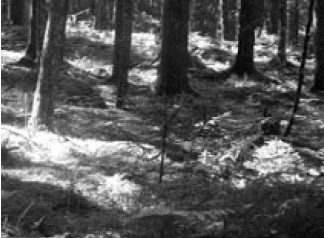 |
|
Figure 30:A red spruce seedling absorbs light and nutrients as it reaches for the sky. |
Animals and birds also make caches of seeds and forget about them. Blue jays, chickadees, and many rodents hide seeds some of which eventually grow. Other animals, such as moles, carry out tunneling which turns earth over in much the same way you would turn your garden over in the spring. The freshly turned soil creates a "garden" for seeds to begin growing.
The most difficult time in a tree's life is getting established once the seed has germinated. Millions of seedlings perish in this delicate stage - animals and fungi destroy them and heavy rains wash them away. There are many reasons why seedlings have trouble getting started. If seedlings are not eaten or destroyed, they compete with each other for food, light, and water. Those that are best adapted for the site and those with superior inherited qualities will grow the best.
Growth of Trees and Plants
Soil, climate, and water are primary influences on tree growth. Many trees do most of their above-ground growing in May, June and July when the water is plentiful and temperatures are not too warm. Early spring is the best time for planting and transplanting trees because they are still dormant, there is moisture in the soil, and the roots are just starting to become active. The plants will have the entire summer to become established.
If plants and trees grow too late into the fall, the new growth will be killed by frost. Plant life in Nova Scotia is adapted to our weather and slow down their growth as fall approaches. Late summer and early fall are important times in the lives of trees as they are storing food for next spring. In winter, plants and trees are dormant.
Plant and tree growth depend on how well nutrients are cycled in the woodlot. Different tree species have varied nutritional requirements and some trees can handle a low level of nutrition better than others. Generally, hardwoods require more nutrients than softwoods. Other plants growing near seedlings can inhibit growth because of their many small, fine roots which take up a lot of nutrients and water.
Growth will also be inhibited if a tree is too crowded. In this case, not enough light, nutrients, and water are available for each tree because there are too many roots competing for limited resources. Trees that have been thinned grow more quickly because they have more space to obtain the important requirements of life, including sunlight.
After light, water is the most critical element required for tree growth. How trees take up water varies, but they all use a vast amount. A single large tree on your woodlot can take up as much as a tonne of water from the soil every day. The ability of a tree to pump water is truly amazing. A suction pump can carry water no higher than about 10 metres. In a tall white pine, nature carries water up to 30 metres.
 |
|
Figure 31: Trembling aspen grows vigorously in full sunlight. |
Most of the water taken up by trees is absorbed through the roots. Less than 1 percent of the water that is taken up is actually used; the rest is eventually released (transpired) through the leaves and needles. As water is carried up through the tree it keeps the tree cool and brings with it most of the nutrients required for growth.
Because tree growth is limited when water is scarce, soil water and moisture in the spring months are keys to a healthy growing forest. Lack of water in the late summer months affects trees as well. Some trees, like birch, which have a longer growing season are affected more by late droughts than pine, maple, ash, beech, and oak which do most of their growing in the spring and early summer. However spring growers may have trouble the following year if a drought affects the moisture of the soil.
Compared to some other parts of the world, the lives of trees in Nova Scotia are relatively short. Balsam fir matures in about 40 to 50 years. Although white pine can live up to 450 years, the average age is about 200 years. The oldest living trees in Atlantic Canada are a red spruce in Fundy National Park that is 445 years old, and an eastern hemlock in Queens County, Nova Scotia that is 420 years old.
 |
|
Figure 32:Dead white pine trees make excellent snags for wildlife nests and perches. |
As we learn more about forest ecology, we have come to recognize a tree's importance as it dies and decomposes. Often called snags, cavity, or wildlife trees, they are used by many species of wildlife. It's estimated that up to one-quarter of wildlife species in Nova Scotia use dying or dead trees during their lives.
 |
|
Figure 33: As a tree begins to break up after death, it becomes habitat for many species of wildlife. |
As a tree ages, the bark loosens or becomes injured by fire, lightning, animals or humans. Injuries, such as broken tops, form entry points for various types of fungus which show up as conks on the tree.
Insects start to invade the bark, making the tree softer and easier to penetrate. Carpenter ants begin mining the wood. Birds, like the pileated woodpecker that eat the ants, drill into the bark. The next spring a smaller woodpecker or other bird that lives in cavities or holes in trees, drills into this soft feeding area to make a nest hole. As the tree decays and the hole becomes bigger, it becomes a home for a family of flying squirrels or a group of wintering raccoons or a nesting area for a wood duck or merganser. A hawk uses the bare branches of the standing dead tree as a lookout post.
 |
|
Figure 33: Cavity trees are initially excavted by woodpeckers, then used by other birds and mammals for nesting, feeding and shelter. |
The tree eventually rots and falls down as activity inside it increases. When the tree falls, a new section of the forest opens, creating space for new plants and trees to grow. The log, although dead, continues to shelter a multitude of life. Fungi, ants, mites, and other insects recycle the log, breaking it down into a smaller form. Other animals like spiders, centipedes, and salamanders come to eat the insects and find shelter. Earthworms and other soil animals eat the remains and their "casts" or waste become part of the soil.
The log becomes useful to many different animals. Grouse (partridge) will use the log as a drumming spot. Small mammals use it as a nesting place. A salamander may bury itself under the log during hibernation in the winter. A porcupine family may live in the hollow.
 |
|
Figure 33: Dead trees are quickly invaded by fungi such as this conk. |
Fungi and bacteria grow in the decaying log. The fungi attach themselves to new tree roots; the bacteria help break down the litter even further. Thus the log further decomposes and feeds the next generations of trees. Eventually a new seedling can grow in the fertile soil left by the decayed tree, and the cycle begins again.
It is important to leave as much woody material as possible on a harvested forest area. The wood will support many types of life and some nutrients and elements will eventually be returned to the soil.
Module 7 - Lesson Four Quiz
| Questions: | 10 |
| Attempts allowed: | Unlimited |
| Available: | Always |
| Pass rate: | 75 % |
| Backwards navigation: | Allowed |
Lesson Five - The Forest Under Your Feet
There is far more life under the surface of your woodlot than there is above. Forest soils teem with life, from microscopic single-celled organisms to rodents like moles and shrews. Most forest soils have a greater variety and number of organisms than agricultural soils.
Most people think of forest soils as a rich dark substance, much like compost. If you dig a shovelful of earth and examine it, you'll discover a complex mixture of fibrous roots, decaying leaves, and crumbling organic matter. Dig deeper, however, and you'll reveal much more about your woodlot soils. First, let's look at how soils are formed.
Rock: A Solid Beginning
The mechanisms of soil formation are the same today as they were millions of years ago. All soils begin as rock, which breaks down over time. It can be challenging to realize that every rock has the potential to be soil someday. We're used to phrases such as "solid as a rock", and tend to think of rock as a permanent substance. But given time, wind, water and sun, all rocks will break down into smaller pieces and eventually become soil. This process is called weathering.
Five factors are central to the formation of soils:
1. Time: soils need time to develop 2. Topography: affects drainage and moisture content
3. Parent material: affects soil texture and fertility
4. Climate: affects soil by temperature and precipitation
5. Living organisms: affects organic matter decomposition and soil biology
Most soils in Nova Scotia are the result of glacial deposits. As glaciers receded some 10,000 years ago, they left a landscape of scoured rock and rubble. As bacteria and other organisms colonized this material, the biological activity formed what we call soil.
 |
|
Figure 36: Plants erode rocks by splitting them into smaller fragments. |
Bacteria multiplied, died and decayed, raising the organic content level of the soil. Seeds found their way to this place and plants, with the assistance of nitrogen fixing bacteria, became established and provided nutrients for other plants.
Once plants became established, they provided the nitrogen that was essential to other forms of life. Gradually, over many years, nutrients began to build up in the soil as plants died and decayed.
The roots of new plants crept into cracks and crevices in the rocks, further contributing to the process called weathering. Acids secreted by lichens and fungi etched new holes in the rocks, providing footholds for mosses that shelter bacteria and fungi.
Over time, the soil was built up and was capable of hosting other plants such as trees and shrubs. Ecosystems of plants and animals were formed.
SOIL TEXTURE
The weathering of rocks eventually forms soils having three primary size classes: sand, silt and clay. The combination of these particles contributes to soil texture. Loams are familiar to most gardeners. A loamy soil has a good mixture of sand (40%), silt (40%) and clay (20%) for plant growth. The texture of a soil can be estimated by rubbing a small amount of moistened soil between your thumb and forefinger.
Sandy soils contain particles that can be up to two millimetres in size. As you rub it between your thumb and forefinger, sandy soil feels gritty. If you moisten sand and try to form it into a ball by squeezing it in your hand, the ball crumbles and falls apart. Sand does not feel sticky.
Silty soil is composed of smaller particles than sand, and they feel smooth and greasy when rubbed. Moist silty soil can often be molded into a ball without crumbling, and silt does not feel sticky.
Clay soils contain the smallest of soil particles. They can be easily formed into a ball, and feel smooth and sticky.
Forest soils contain a combination of sand, silt and clay. The relationship between texture classes can be viewed by using a texture triangle.
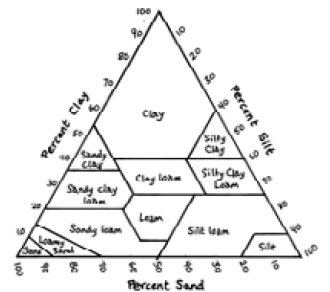 |
|
Figure 37: This texture triangle can be used to determine the com-position of sand, silt and clay in a sample of soil. |
Living Soil
A healthy community of soil organisms is vital to the health of forest soils. Soil organisms provide nutrients for plant growth, decompose organic matter, promote soil structure and porosity, and help break down pollutants. In the presence of organisms, organic matter is constantly being recycled.
Most decomposers of organic matter live their entire lives in the soil, consuming plant matter, dead animals and waste products. A soil's fertility directly depends on the abundance and level of activity of soil organisms. Their efforts ensure that nutrients are recycled and organic matter is distributed throughout the rooting zone, holding water and nutrients for plants to use.
A single plant may have more living material beneath the soil than it does above the surface. Plant roots are covered in tiny hairs which greatly increase the surface area of the roots, allowing a much higher uptake of water and nutrients. These root hairs release chemicals into the soil that are attractive to nitrogen-fixing bacteria. The specialized bacteria are compatible with a limited number of plant species, and form associations with them by stimulating them to form nodules on their roots. The bacteria live in the nodules and convert gaseous nitrogen to ammonia which is used by both the plant and the bacteria. In turn, the plant supplies water and nutrients to the nodules of nitrogen-fixing bacteria. This partnership is called mutualism, in which both partners benefit from the presence and activity of the other.
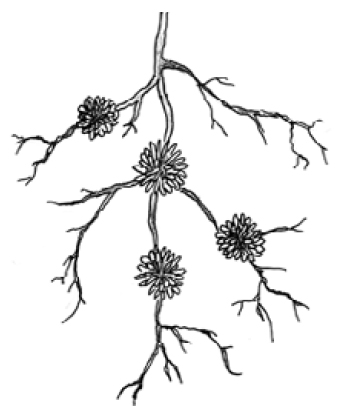 |
|
Figure 38: Root nodules containing nitrogen fixing bacteria. |
Nodule-bearing plants are able to colonize some of the most barren environments on Earth, and live in places where plants without nodules cannot initially survive. After the nitrogen-fixing plants have lived in an area for a time, and converted nitrogen into an available form, other plants are able to colonize the area.
Other important relationships that exist between plants and other forms of life are partnerships with fungi. Fungi can access tiny pores in soil, taking up water and minerals. However, fungi rely on the photosynthesis of plants to provide energy and food.
Long strands of fungi, called mycelia, wrap around and entwine the roots of plants. Although they have a different structure than roots, mycelia serve as an extension of plant roots and are able to tap into a much greater volume of soil than roots alone. Strands of fungi also have the ability to make phosphorus and sulfur available to the plant, and are important in the cycling of these elements.
Fungal strands that partner with the roots of plants are called mycorrhizae. At first glance, roots that are surrounded by mycorrhizae appear moldy, and before there was a good understanding of the roles that fungi have in helping plants grow, many people assumed that all fungi was harmful to plants. Further research revealed that some fungi can improve the health of plants, and can be essential to the plants' survival. Other fungi, such as Armillaria, can cause root rot and can be serious problems in forest soils.
When most people think of fungi, they think of mushrooms. Actually, mushrooms that you may see in your woodlot at certain times of the year are only a small part of the entire fungal organism. Strands of mycelia may reach out for many metres from the mushrooms, which are the fruiting bodies, or reproductive parts, of the larger organisms that live in the soil. Often, colonies of mushrooms can be found near the bases of trees. These clusters of mushrooms indicate that millions of strands of mycelia are sharing resources with the tree. Think of the trees and other plants on your woodlot, and imagine the vast network of mycorrhizae that exists beneath the surface of the soil. Think of the vast amounts of water, nutrients and energy that flow beneath your feet. Think of the billions of soil organisms that are working to mix mineral soil with organic material, and the life-and-death scenarios that are being played out in miniature as they feed upon one another, providing more organic material to the immense food web of the soil.
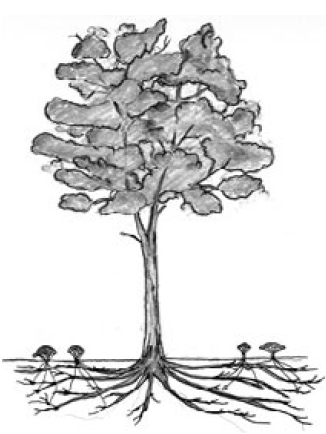 |
|
|
Figure 39: Strands of fungi called mycorrhizae form special relationships with roots of plants. |
|
Healthy soils are teeming with life. A few teaspoons of soil from your woodlot can hold millions of bacteria, which are the foundation for all life in the soil. There are millions of species of bacteria in a single square metre of soil, and total populations can be in the vast feast for predators.
Because bacteria are so small, single-celled organisms called protozoa can feed on them. As organisms increase in size, there are fewer of them in a square metre of soil. For every protozoa there can be nearly a thousand bacteria.
 |
|
|
Figure 40:Microscopic soil bacteria are the great decomposers of organic matter. |
|
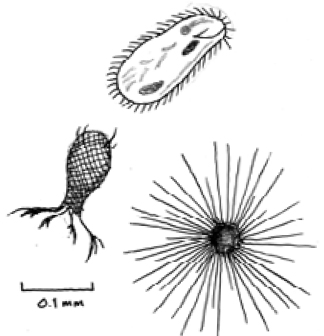 |
|
|
Figure 41: Soil protozoa feed on bacteria and provide nutrients for other soil organisms. |
|
Protozoa are, in turn preyed upon by nematodes: tiny worm-like animals that average about a millimetre in length. Nematodes, with their long sinuous bodies, can move among the small spaces between soil particles in search of prey. There may be as many as five million nematodes in a square metre of soil.
 |
|
|
Figure 42:Tiny nematodes move through the soil in search of food. |
|
Roaming about the loose humus are small spider-like creatures called mites, and tiny insects called springtails. Mites are often covered in a hard shell that helps them avoid predation by larger animals. Mites can be over a millimetre in length and there can be up to 400,000 mites in a square metre of soil. While many species of mites are predaceous, some are not, and burrow through the humus, eating, digesting and excreting plant material.
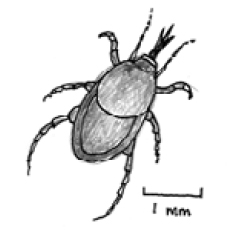 |
|
Figure 43:Soil mites prey on small insects and nematodes. |
Mites and springtails are among the most numerous arthropods on Earth. Springtails have uniquely adapted to life in the moist, dark soil. They have very weak eyesight and, like all insects, springtails have six legs. Springtails also have a forked mechanism "like a spring" that allows them to escape predators. During winter, the surface of snow is often peppered with tiny jumping springtails, which have earned them the name "snow fleas". In the soil, springtails feed on decaying plant material and are preyed upon by other insects and mites.
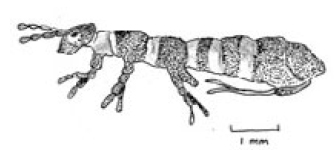 |
|
|
Figure 44:Springtails can move quickly through the soil with special spring-like appendages. |
|
The incredible variety of insects on Earth has made them an important component of healthy soils.
Insects help decompose plant and animal material, and are major predators in the battle of life and death in the soil. Besides springtails, soil insects include ants, crickets, beetles, earwigs and weevils. Other insects, like some species of moths, spend part of their life cycle in soils. All contribute to the richness of the humus, with their tunneling, feeding and excreting activities.
Perhaps the most familiar inhabitants of the soil are worms. Both potworms and earthworms are important movers of soil, which keeps the soil well mixed and aerated. Potworms look like miniature earthworms, and both potworms and earthworms digest plant matter and excrete it back into the soil. After a rainy summer night you may find small mounds of excreted material on your lawn, next to holes used by earthworms. The high water content of the soil, resulting from rain, has forced earthworms to the surface during the night. These mounds, called castings, are composed of a mixture of mineral and organic matter. It is easy to see why earthworms are called the great movers of the Earth! Nearly all species of earthworms that are found in abundance in Nova Scotia's soils have been introduced from other countries.
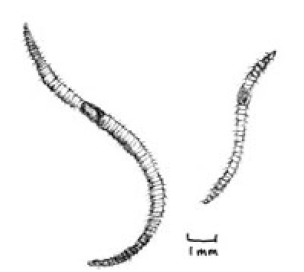 |
|
Figure 45:Potworms are significant decomposers of organic matter in soils. |
Other visible inhabitants of the soils of your woodlot include snails, slugs, millipedes and centipedes, which all play roles in mixing, mulching and decomposing plant and animal material.
Some larger animals can be difficult to find, unless you go looking for them. Many species of amphibians and reptiles have nests in the upper parts of the soil and under rocks and decaying logs. Amphibians like newts and salamanders seek shelter beneath logs where the environment is cool and moist. Features of your woodlot such as large logs and coarse woody debris are ecologically significant. Eastern garter snakes build their nests in shallow burrows and are contributors to soil health. Larger mammals such as moles, shrews, white-footed mice and eastern chipmunks are effective excavators of forest soils. Their tunnels and dens contribute to the aeration of soil and provide habitat for other organisms.
Soil Structure
We've seen how soil organisms and organic matter can have far-reaching effects on the health of your woodlot. Now let's look closer at the mineral soil component.
If you have a woodlot road, you are likely familiar with the distinctive horizontal bands of colour of exposed soil next to ditches. These layers, or horizons, can tell us about the history of the soil, its composition and the chemical reactions that have taken place.
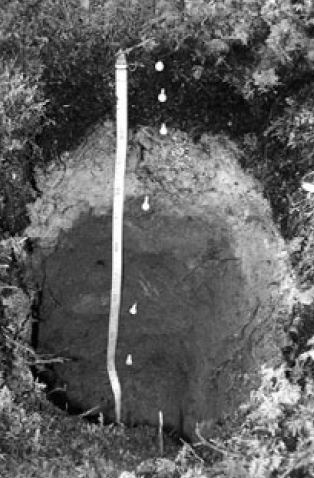 |
|
Figure 46: A soil profile reveals the horizons present in forest soils.(NSDNR) . |
Whenever organic matter or elements such as iron and manganese accumulate, react or combine in soil, they often form colours that can be used to interpret details about the soil. Each horizon has a unique story that we can attempt to read.
At the surface of the soil, the organic (O) horizon is made up of three separate layers. On the very top is the litter (L) layer that consists of dead plant material that has accumulated over time. Twigs, leaves, animal remains and wastes, and other detritus of the forest are distributed loosely on the forest floor. Some decomposition has begun to take place, but the structure of the litter is mostly intact.
Below the L layer is a band of organic material that appears as if it has been finely mulched. This fermentation (F) layer consists of the material that results from the initial breakdown of litter. Soil organisms play a major role in the decomposition of litter as leaves crumble, fungi feed on woody material and snow and rain break the larger debris into smaller pieces.
Humus (H) is the next stage in the process of decay, and the original plant material can no longer be identified. Some humus particles are small enough that the action of water leaches them downward into the mineral soil.
Below the organic horizon are the first soil layers that contain mostly minerals and inorganic elements. In some cases, insects and earthworms mix humus with the top layer of mineral soil, called the A horizon.
Deeper still, the B horizon receives minerals that have passed through, and may be altered by, the A horizon. Some organic matter may find its way here in limited amounts.
Below the B horizon, and mostly undisturbed by soil formation processes, lies the C horizon.
Module 7 - Lesson Five Quiz
| Questions: | 10 |
| Attempts allowed: | Unlimited |
| Available: | Always |
| Pass rate: | 75 % |
| Backwards navigation: | Allowed |
Lesson Six - Water and Wetlands
Watercourses
Clean water is vital to the health of our forests and to our human communities. Forests help protect the quality of water by providing shade and nutrients for aquatic life. Watercourses that run through your woodlot should be protected as much as possible.
The Nova Scotia Forests Act defines a watercourse as "the bed and shore of a river, stream, lake, creek, pond, marsh, estuary or salt-water body that contains water for at least part of each year."
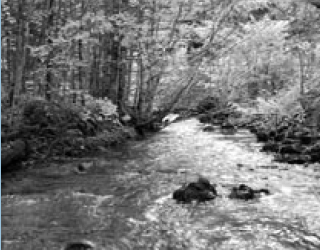 |
|
Figure 47: Regulations protect watercourses from damage that may result from forestry operations. |
In 2002, the Province enacted new regulations to protect watercourses, including restrictions on harvesting forests which border watercourses that are at least 50 cm in width, and the minimum distance that forestry vehicles can approach watercourses.
Special Management Zones
The forested areas on each side of a watercourse are called Special Management Zones (SMZs). They are also called riparian zones, greenbelts and buffer zones. SMZs are crucial in protecting water quality and providing wildlife habitat. Currently, SMZs on either side of a watercourse must have a minimum width of 20 metres. Where the banks of the watercourse are more steeply sloped, the zone must be wider.
SMZs provide many unique ecological features. They function as transition areas where land meets water, providing important wildlife habitat for species that need both land and water to survive, such as muskrat, mink and otter.
The vegetation in SMZs assists in filtering silt and mud before it flows into the watercourse, and the roots of trees and shrubs help prevent erosion by holding soil in place. Debris and insects falling from trees provide food for aquatic animals. Shade from the trees helps keep the temperature of the water cool.
 |
|
|
Figure 48: Special management zones are required on both sides of watercourses that are over 50 cm in width. |
|
It is important to maintain continuous tree cover in SMZs, to provide watercourses with maximum protection. Provincial regulations require that openings in the tree canopy of SMZs be no wider than 15 metres. In addition, a minimum basal area of 20m2/ha of living trees must be maintained.
Small trees, non-commercial trees and other vegetation should be disturbed as little as possible in SMZs. These plants protect watercourses from runoff and erosion.
 |
|
|
Figure 49: Harvesting too close to watercourses can result in erosion of stream banks and siltation of water. |
|
The Ecology of Vernal Pools
Vernal pools are among the most valuable habitat features of the forest. These small seasonal ponds support a remarkable variety of insects, amphibians, reptiles and aquatic invertebrates. Because they flood during the spring and become dry later in the year, vernal pools do not support fish. This absence of predatory fish is an important feature of these hotspots of biodiversity.
What makes vernal pools unique from other ponds and small lakes? To fit the definition, vernal pools must:
• Occur in or next to forests
• Have no connection with other watercourses or water bodies
• Be small and shallow vFill seasonally and dry up annually or every few years
• Lack fish populations vHost animals that are adapted for seasonal flooding and drying
When trees are adjacent to vernal pools, the trees help the water stay cool and contribute food to animals living in the pools. Leaves cover the bottoms of vernal pools each autumn, which adds to the organic content and habitat for plant decomposers.
 |
|
|
Figure 50: Vernal pools provide valuable wildlife habitat and contribute to the biodiversity of woodlots. |
|
Most vernal pools occur in natural depressions in the landscape such as small hollows carved out by glaciers or in pits where trees were uprooted during wind storms.
Shallow pools allow sunlight to rapidly warm the water, increasing the rate of growth of aquatic animals and stimulating the growth of photosynthetic algae. When vernal pools dry later in the year, the exposure of plant material on the bottom of the pool increases its rate of decomposition and encourages the release of nutrients.
 |
|
Figure 51: Red efts are amphibians that inhabit vernal pools and watercourses. |
More than 500 species of animals have been found in vernal pools. Many of these animals are adapted to living their lives in aquatic conditions in the spring, and move to another area later in the season.
Vernal pools are important habitat for insects such as caddis flies, mayflies and mosquitoes. Once they hatch from their aquatic stages, they are an important food source for songbirds that live in the adjacent forest. Several species of crustaceans make vernal pools their homes, including fairy shrimp and water fleas. Snails, worms and water mites all contribute to the food web and to the diets of spotted salamanders, wood frogs and spring peepers.
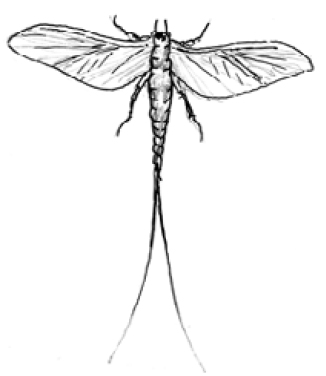 |
|
|
Figure 52: Mayflies are insects that are important in the food chains of vernal pools and watercourses. |
|
Each spring, breeding populations of salamanders migrate to vernal pools to lay their eggs. These overland migrations can be fascinating to watch. Vernal pools retain water long enough in the spring for aquatic animals to complete their life cycle, and help prevent the eggs of amphibians and other animals from drying out.
The presence of salamanders in the ecosystem is important because salamanders require moist, dark habitat and plenty of earthworms and insects for food. If there are healthy populations of salamanders, we know that populations of other species are likely healthy as well. In turn, nearly all predators feed on salamanders, underlining their importance in the food web.
 |
|
|
Figure 53: The presence of salamanders can indicate the health of forest ecosystems. |
|
The Ecology of Streams
The structure of the bottom of a stream influences the kinds of life that can be supported there. Most streams have both quickly-flowing riffles and quiet pools. Where the water flows rapidly, algae often coat the smooth stones that line the bottom of a stream. As the algae grow larger, they get swept away and collect in the slower-flowing pools as food for aquatic insects and other invertebrates.
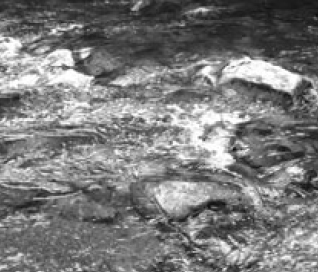 |
|
Figure 54: Healthy stream bottoms are often composed of gravel. |
Fish eggs, insect larvae and crustaceans require a combination of fine and coarse particles for shelter. A sandy bottom does not provide much cover or opportunities for feeding, and the sand is easily swept away. Solid bedrock does not provide protection against stream currents and only the strongest organisms are able to inhabit these sites. Caddis fly larvae, which build tubular nests of stone particles, are often found attached to bedrock in streams.
Gravel bottoms are often the most productive areas of fast-flowing streams. Gravel stream bottoms have much more surface area per square metre than other types of substrate and small aquatic organisms are able to seek shelter among the nooks and crannies.
 |
|
Figure 55: Brook trout prefer clean, cool water and gravel stream bottoms. |
Here, mayfly larvae, blackfly larvae and stoneflies seek shelter and food, and later provide food for brook trout. Gravel contains a distribution of particle sizes that makes it a good medium for fish to lay eggs. Once the eggs hatch, fish fry are able to avoid predators among the coarse gravel.
In slow-moving streams, less oxygen is available to aquatic organisms due to less mixing of the air and water. Silt and decaying organic matter accumulate on the bottom and spaces among the gravel and rubble fill with sediment.
 |
|
Figure 56: Rivers often contain slow-flowing water that allows sediments and organic matter to settle. |
Over time, erosion may cause streams to become wider and shallower. The temperature of the water may begin to increase as silt clouds the water and absorbs solar radiation. Pools may begin to form, attracting aquatic insects, burrowing crustaceans and freshwater mollusks. As the water slows, aquatic vegetation takes root in the mucky bottom, further adding to the organic debris. Populations of plankton and protozoa become higher and brook trout may be replaced by warm-water fish, such as smallmouth bass and yellow perch.
Stream bottoms are usually associated with the types of rock that exist in an area and the location of the stream on the landscape. Rocks such as granite are not easily eroded, and streams may be filled with large boulders which offer little habitat for smaller organisms. Sandstone, on the other hand, is more quickly broken down into small particles by the action of water. The best stream bottoms are often made up of combinations of hard and softer rocks, like that found in gravels.
 |
|
Figure 57: Some rocks, such as granite, erode slowly. |
Construction of woodlot roads near watercourses must be undertaken with extreme care. The installation of culverts and bridges can have negative impacts on stream flow and aquatic habitat.
The velocity of water increases as it enters a round culvert, and ?sh may have dif?culty moving upstream. The increased flow of water can scour out the stream bottom near the culvert outlet, making it even more difficult for fish to move upstream.
Handle with Care: The Ecology of Wetlands
Wetlands are among the richest ecosystems on Earth. They support an incredible diversity of life at a number of different trophic levels. Halfway between terrestrial and aquatic ecosystems, wetlands can develop during the course of a stream�s journey to the ocean, or along the margins of lakes and ponds.
Wetlands perform important functions in the ecology of the landscape, including:
• Absorbing water like a sponge and releasing it during dry season
• Reducing runoff and slowing erosion of stream banks
• Storing carbon on that it enters the atmosphere more slowly
• Providing wildlife habitat, including that for endangered speices.
Water sources for wetlands may be overland flow and seasonal runoff, or the water may originate from within the ground, emerging as springs and seeps.
Wetland soils have unique properties and are called hydric soils. Chemical reactions in the upper layers of soil often change the colours in wetland soils. This is an indication that nutrients and elements are being removed from the silt by the action of water, called leaching.
A Swamp by any other Name: Types of Wetlands
Although eight different categories of wetlands have been identified in Nova Scotia, there are three basic types of wetlands that are likely to be encountered in the forest: wooded swamps, marshes and bogs.
WOODED SWAMPS
Wooded swamps are poorly drained areas of forest which retain a treed cover. Only trees that can withstand a high water table are found in these areas, such as red maple and black spruce. Many species of wetland vegetation can inhabit wooded swamps, including Canada holly, huckleberry and honeysuckle. Because of annual leaf-fall, fresh organic material is constantly being scattered across the surface of the swamp. Thick mats of decomposing leaves are typical features of wooded swamps.
In the small pools of dark water, bacteria and protozoa break down the tough fibers of the leaves, and insects are abundant. Among the tree branches above, songbirds fly aerobatics as they feed on the wing.
MARSHES
Marshes are wetlands that do not usually have a tree cover. They commonly feature open water, with thick vegetation such as grasses, rushes and sedges. Plants like cattails and sweet flag are often found in marshes, and are easy to identify.
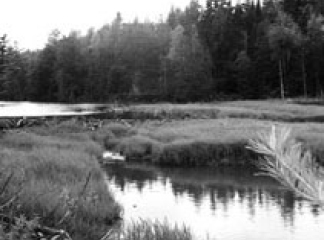 |
|
Figure 58: Beaver dams are often present in marshes, and provide habitat for many species of wildlife. |
Marshes are like magnets to wildlife, attracting hundreds of species to their rich food webs. They are home to many species of songbirds, including red-winged blackbirds, ruby-throated hummingbirds, marsh wrens and red-eyed vireos. Great blue herons and least bitterns hunt for food along the edges of marshes. Green-wing teal may whistle in for a landing as they look for lunch among the bulrushes.
At night, little brown bats flicker silently above the open water of marshes, scooping mosquitoes and moths from the air.
Like all wetlands, marshes play an important role in the water cycle by maintaining a delicate balance between precipitation and evapotranspiration. The dense vegetation ensures that organic matter is continually replenished as food for the great consumers like bacteria and protozoa.
BOGS
Like marshes, bogs support low-growing communities of plants, but tend to be less rich in nutrients. Bogs in Nova Scotia are usually acidic, relatively low in oxygen and decomposition is slow. Fens, which are less common, resemble bogs in outward appearance, but are alkaline rather than acidic.
 |
|
|
Figure 59: Bogs can be inhospitable to many forms of forest life, but may also provide habitat for endangered plant species. |
|
Bogs are often carpeted in thick layers of sphagnum moss, which readily absorb water and sink beneath their own weight. Because of the slow rate of decay, the moss is compressed into saturated beds of peat, where anaerobic bacteria break down the moss over many decades. Because of the low microbial activity, peat may form at the rate of less than a millimetre each year.
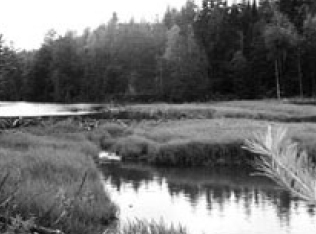 |
|
Figure 60: Pitcher plants, which are carnivorous, are often found in Nova Scotia bogs. |
Among the other plants found in bogs, lambkill, rhodora and Labrador tea are common. Unique insect-eating pitcher-plants or sundews may also be present. Stunted black spruce trees attempt to gain a foothold in bogs, but the low fertility and high water table discourages tree growth. Over centuries, bogs may fill in and begin to support other plants and animals.
Field mice and red-backed voles often scurry between clumps of grass in bogs, creating shallow tunnels in the vegetation. A hawk such as the northern harrier may patrol the vicinity, ready to swoop at the least shadow of movement.
The next time you walk in a bog, think about the billions of bacteria that are working silently beneath your feet. Many of them are living in very low levels of oxygen, using chemical reactions with soil elements to obtain oxygen. These are anaerobic bacteria, and they transform non-toxic forms of iron, sulfur and other elements to toxic forms, such as ferrous iron and hydrogen sulfide, ammonia and methane. This discourages other plants from becoming established in peat bogs.
 |
|
|
Figure 60: A surprising number of plant species can be found in bogs. |
|
 |
|
Figure 60: Wetlands contain some of the richest biodiversity on Earth. |
In the past, many wetlands were drained by humans for agriculture and development. Today we recognize the importance of wetlands in healthy ecosystems, and regulations are in place to protect them.
Module 7 - Lesson Six Quiz
| Questions: | 5 |
| Attempts allowed: | Unlimited |
| Available: | Always |
| Pass rate: | 75 % |
| Backwards navigation: | Allowed |
Lesson Seven - Woodlot Stewardship and Sustainability
We've learned that a good understanding of ecology can help woodlot owners make wise decisions about managing their land. This caring for and nurturing of the land is called stewardship. Good stewardship means that the land and the life in and around it is being properly tended.
Owning and managing a woodlot is a responsibility that should not be taken lightly. Whether you have inherited or purchased a woodlot, it is up to you to manage your woodlot sustainably. Sustainable resource management means using and protecting your woodlot resources in ways that provide for present economic, social and environmental well-being while conserving the potential of your woodlot for future generations.
We've seen how woodlots can be home to an incredible variety of life, both above and below the ground. Through best management practices, forest operations can be carried out on most woodlots without significantly damaging the environment. One forest harvesting system that has been over-used is clear cutting, in which most or all of the trees are removed from an area of forest. Clear cutting is used to manage even-aged stands of trees that are all ready for harvest at the same time. The decision to clear cut means that a woodlot owner can only harvest every 40 to 50 years, when the trees are mature again. As well, potential areas of wildlife habitat are removed when forest stands are completely harvested, and valuable nutrients are removed from the site.
Options exist for land owners who wish to manage their woodlots in holistic, ecosystem-based ways. Many owners have traditionally employed even-aged techniques, ensuring that most or all of the trees in a forest stand are within the same age class. This system of management is relatively easy and economical to implement. Silviculture treatments such as pre-commercial thinning, commercial thinning, clear cutting and shelterwood harvesting are commonly used to increase the growth of trees and establish new regeneration. Lessons in the use of all of these silviculture methods can be found in earlier modules of this series.
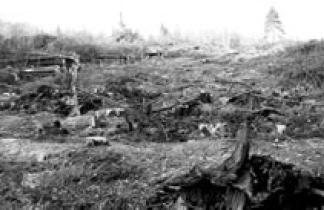 |
|
Figure 62a: Whole tree harvesting removes many nutrients from a forest site. |
Uneven-aged management is adopted when woodlot owners wish to conserve a range of age classes of trees on their woodlots or in a forest stand. Selection harvesting is used to maintain a regime of partial cutting in which most of the poorest quality trees are removed early in the management cycle. The best quality crop trees can then be individually tended for maximum market value. Treatments which promote individual tree quality include crop tree release and crop tree pruning.
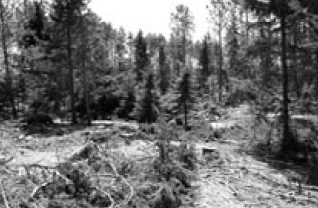 |
|
Figure 63: Selection harvesting can be used to promote different age classes of trees in a woodlot. |
Both even-aged and uneven-aged management can be used to enhance wildlife habitat features. Be sure to leave as many snags and cavity trees as possible, and use caution near watercourses and vernal pools.
In accordance with provincial regulations, clumps of trees must be left standing in forest operations. The role of the clumps is to preserve a portion of the stand as legacy forest. Because the clump must be composed of the same tree species and tree sizes of the area being cut, some genetic material of the original stand will be preserved. Existing wildlife habitat will also be conserved. Where forest stands exhibit old forest characteristics, a forest biologist should be consulted to determine the best options for management.
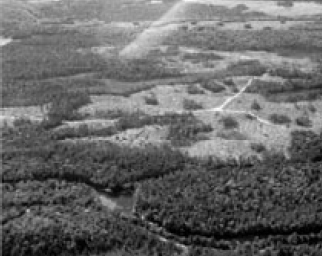 |
|
|
Figure 64: Wildlife clumps are required to be left in clearcuts over 8 hectares in area. |
|
Care should be taken to avoid damaging forest soils during any forestry operation. By choosing the best season of the year to operate forestry vehicles, rutting and soil disturbance can be minimized. Where the soil is imperfectly or poorly drained, a winter operation may be the only option to avoid soil compaction and damage. Soil compaction results in the loss of soil porosity, and water will pond or run off if the soil loses its capacity to absorb water.
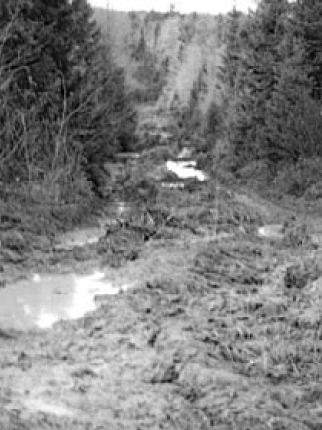 |
|
Figure 65: Soil compaction and rutting can occur if forest opera-tions are improperly planned. |
A woodlot management plan is an important tool in determining the most appropriate steps to take in managing your woodlot. Your objectives are very important when planning the future of your forest, and a management plan will match the future potential of the resources on your woodlot to your objectives. Woodlot management plans are usually prepared by foresters and forest technicians who are familiar with the ecology of the forests of Nova Scotia.
Climate Change
Climate change is caused when carbon dioxide and methane, called greenhouse gases, are released into the atmosphere in such quantities that solar radiation which reaches the Earth's surface cannot escape. As the temperature changes within the atmosphere and at the surface of the Earth, the circulation of water and air are thrown off balance, and drought, flooding and wind storms become more frequent.
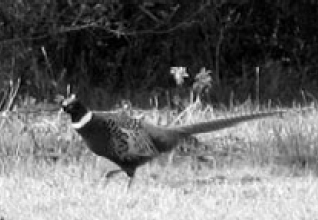 |
|
Figure 66: Climate change may bring new wildlife species to Nova Scotia. |
In Nova Scotia, it is expected that temperature will increase by only a few degrees over the next century, but that will be enough to cause significant changes in the plant and animal communities that we are used to seeing. There may also be more precipitation in rain and snow, and wind events such as hurricanes may become more common and more severe during the autumn months. As the Acadian Forest slowly changes over the next few centuries, plants and animals that are found further south may become residents here.
Carbon levels in the atmosphere normally fluctuate over time, as the processes of carbon release and carbon capture occur. Healthy forests can slow the rate of climate change by absorbing greenhouse gases from the atmosphere. Trees are natural filters that "scrub" carbon dioxide and methane from the air before releasing it as oxygen. Without plentiful forests, the Earth's climate would change much more rapidly.
Integrated Resource Management
Integrated resource management is an important concept that promotes the use of forest management techniques to meet non-economic values such as conservation of wildlife habitat, protection of old-growth forest and preservation of views. Managing woodlots for multiple values is a concept shared by most woodlot owners.
We'll look at three examples of woodlot owners in Nova Scotia who have very different kinds of woodlots, but manage their properties for different values. You will see how a basic knowledge of woodlot ecology has helped them in planning and managing their resources. Similarly, a good understanding of forest ecology will allow you to make informed decisions about the future of your woodlot and the exciting possibilities that lay ahead.
 |
|
Figure 67: Making wise woodlot management decisions is up to you. |
Module 7 - Lesson Seven Quiz
| Questions: | 10 |
| Attempts allowed: | Unlimited |
| Available: | Always |
| Pass rate: | 75 % |
| Backwards navigation: | Allowed |
Case Studies
Travis owns several woodlots in Lunenburg County, where he has excelled in managing them with an eye to the future. Virtually growing up in the woods, Travis has made a life-long study of the ecology of his forests, but is quick to point out that he still doesn't have all the answers.
"I manage my lots in the only way it can be done - slowly and carefully," Travis says. "It is important to maintain all the pieces of the puzzle, because if something is thrown away through neglect, we will likely miss it later when it's too late."
Walking through Travis' red oak, white pine and hemlock stands is like strolling in a well-tended garden. Nearly every tree is given an opportunity to develop to its full potential. Travis undertakes selection harvesting, crop tree release and crop tree pruning to select the best growing trees and provide them with as much light, space and nutrients as Nature can afford. Snag and cavity trees are maintained for wildlife use as much as possible, although working around dead trees can be a safety issue.
He is careful to reduce soil damage by operating during times of the year that the ground is dry. "It rarely freezes here now," Travis states, adding that 20 years ago there was more cold weather for longer periods. "Things are changing faster than they should," he says.
Looking after all the pieces mean that Travis has an abundance of forest vegetation, including witch hazel, wild raisin and huckleberry. These shrubs provide good wildlife habitat and their leaves add nutrients to the forest floor each autumn. "We have very rocky soil here, and every bit of natural fertilizer helps build a good soil base," he says.
Travis does all of his cutting by hand, using a chainsaw. "I'm a bit old-fashioned that way," he says, "but if you treat the forest the way it should be treated, it will pay big dividends in the future."
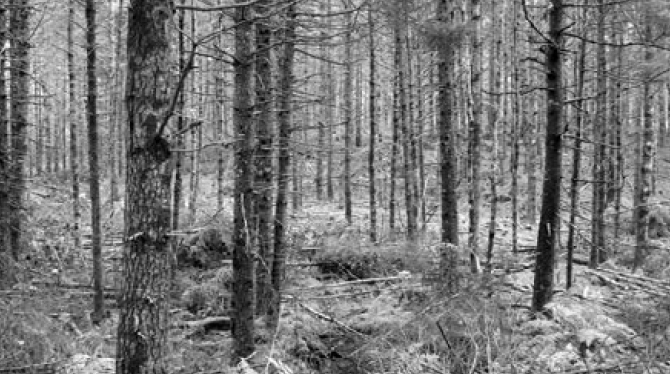 |
|
Figure 68:Travis manages his woodlots carefully, and spends much of his time planning. |
Case Study 2
"You don't have many options when your whole woodlot is balsam fir and white spruce," says Rod, as he unhooks the tongs from a spruce log being pulled by a black Belgian named Chester. His entire 40-hectare (100-acre) woodlot was once agricultural fields which were abandoned soon after the Second World War.
All of Rod's trees are about the same age, creating challenges for his plan to convert his woodlot to an uneven-aged forest with several species of trees. He began cutting patches in the heavy softwood stands about 20 years ago, making openings where he thought that natural regeneration would occur. "I guess it's like clear cutting, but on a smaller scale," Rod says.
"One thing I want to avoid is highgrading - just taking the best and leaving the rest."
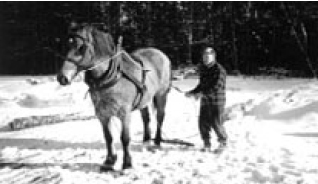 |
|
Figure 69:Horse logging is slow, but can be used in harvesting small patches of forest. |
He had hoped that young spruce would eventually fill the harvested areas, but only a few patches of poor-quality fir became established. The fir doesn't look healthy. "I'm cutting 40-year-old trees that look like they're 60 and already have heart rot," he says. Sound 60-year-old fir is almost unheard of now. If climate change is responsible for this - and I think it is - I'm changing my ways for managing my woodlot, and keeping my options open."
"These soils were run-out a half-century ago," Rod says. "I dug a few soil pits a couple of years back and they didn't look promising." He found that a heavy organic layer from field sod was preventing new trees from growing, and moisture was quickly draining away through the loose gravel soils. Tests indicated that the soil was acidic, which could also prevent good growth for many species of plants.
Rod continues to keep his clearcuts small, and it is often necessary to clean up wind-thrown trees along the edges. "There is a hardpan layer about a foot under the surface that keeps the roots shallow, leading to lots of tossed trees," he says.
Determined to break up the age classes and improve the soil of his woodlot, Rod has planted most of the patch cuts with white pine, hemlock and red spruce. "So far the results look promising," he says, "but it will take another 20 years before my lot will be where I'd like it to be: an uneven-aged forest with six or eight tree species native to the Acadian region."
 |
|
Figure 70:Openings are planted in a variety of tree species. |
Undeterred by deer that browse the planted hardwoods, Rod has had to protect planted sugar maple, yellow birch and white ash with chicken-wire fencing. "It's expensive and time-consuming, but it's an investment," he states. "If I'm not prepared to put in a good effort, I shouldn't expect good results."
Case Study 3
The hardwood slopes of western Cape Breton are particularly magnificent in the fall as they catch the golden glow of the setting sun. It is in this place that Steve and Cathy see a bright future for their woodlot and their children. They are proud of the decisions and hard work that has brought the 100 hectare (247-acre) woodlot to its present condition.
"We learned that species like sugar maple thrives in the shade, and that yellow birch prefers to seed in fresh mineral soil, and ash and red maple are not so shade-tolerant," indicates Cathy. "We know that we have good forest soils on this slope, and we want to take full advantage of the ecology of the site to maintain a healthy forest. We've also heard that an insect called the emerald ash borer is a potential future threat, so we're not concentrating on managing for ash."
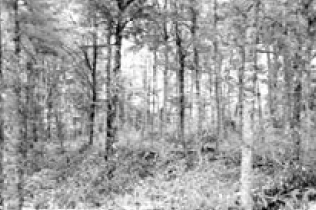 |
|
Figure 71:Tolerant hardwoods can be managed in uneven-aged stands. |
Despite having a well-built network of roads, Steve and Cathy's woodlot also has lots of running water. Seeps and springs are plentiful among the hardwoods, and a small wetland has three rare plant species that Cathy has identified from field guidebooks. In two places where the roads cross watercourses, permits were needed and culverts were installed. "We were surprised that such large culverts were required, but in the spring a lot of water runs down this mountain," says Steve.
With the help of a local forestry contractor, Steve and Cathy are managing their woodlot using selection harvesting. At least four age classes of trees are represented on the woodlot, and they employed a forestry consultant to mark trees for the contractor to harvest. "We were happy to see wildlife trees chosen and retained for the future," says Cathy. "We know that fishers are using our woodlot, and a goshawk nest is close to the north boundary line. We want to preserve their habitat as much as possible, while still harvesting good quality trees for saw logs and others for fuel wood."
With their two young children, Steve and Cathy make weekend trips to the woodlot to revel in its natural beauty. Two vernal pools have been identified and no harvesting equipment is permitted to come close to these sites. The forest roads make good walking and cycling trails, and other paths cut through the woodlot for cross-country skiing.
Steve reflects, "I guess stewardship means different things to different people, but to us it simply means that we're looking after our property as best we can, hoping that our children will have a good opinion of what we've tried to accomplish."
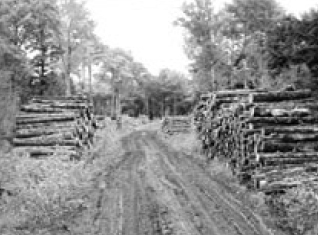 |
|
Figure 72: Good decision-making leads to healthy woodlots and a solid future. |
Glossary of Key Terms - Module 7
Acid rain: A pollutant produced when too much sulfur dioxide and nitrogen oxide are released into the air from electrical plants, smelters, other industries, and vehicles. The chemicals fall with rain and affect soil and water health.
Amino acids: The building blocks of proteins, essential for all life.
Amphibians: Animals that lay their eggs in water or moist places and have soft skin. Salamanders and frogs are examples of amphibians in Nova Scotia.
Anaerobic: In the presence of little or no oxygen.
Basal area: The area in square metres of the cross section at breast height of trees on a hectare.
Best management practices: Forestry operation procedures that strive for operator efficiency and consider potential negative impacts on the environment.
Bog: An area of land where water drainage is blocked; they all have cushiony vegetation (mosses), and an accumulation of peat.
Browse: To eat the twigs and leaves of woody plants. Deer, moose, and hares are browsers.
Cambium: The layer of tissue between the bark and wood from which new wood and bark develops.
Canopy: The top of a forest formed by the leaves and branches of the trees. The density of the canopy determines how much light reaches the forest floor.
Carbon Cycle: One of the essential nutrient cycles. Carbon dioxide is taken from the atmosphere to make food energy and then stored in trees or decayed plant and animal tissue.
Carnivores: Animals that eat animals, e.g., trout eat insects, bobcats eat hares.
Cavity trees: Living or dead trees with natural or excavated holes or cavities.
Climate: Light, temperature, wind, lightning, carbon dioxide, and precipitation combined.
Commercial thinning: A thinning in which harvested trees are removed from the site and used for commercial purposes.
Communities: Groups of plants and animals that live together. Soil and climate largely influence how communities are made up.
Coniferous: Trees with cones and needles; softwoods.
Crop tree pruning: Removing the lower branches of a crop tree to increase future wood value.
Crop tree release: Providing space, by cutting competing trees, on at least two sides of a tree for increased growth and future wood value.
Deciduous: Trees with leaves which fall off in the autumn; hardwoods.
Decomposers: Fungi and animals which break down once living material, producing essential nutrients for new forest.
Dendrochronology: The study of tree history through tree rings.
Diversity: An index of the variety of plants and animals in an ecosystem.
Ecology: The study of living things and their relationship to their environment, home, or community.
Ecosite: A particular area with similar conditions or characteristics of vegetation, soil, and climate.
Ecosystem: An interrelated and interdependent community of plants and animals and their habitats.
Edge: A zone created where two stands, two habitat types, or two successional stages meet.
Energy flow: How energy moves through an ecosystem. In the forest sun is the main energy source. This energy is converted to green plants which in turn are eaten by animals and decompose to be recycled into nutrients and used again.
Evapotranspiration: The combined loss of water from an area by evaporation from the soil surface and by transpiration from plants.
Field capacity: The percentage of water remaining in a soil after having been saturated and after free drainage has ceased.
Food chain: "Who eats who" in the ecosystem.
Food web: The groups of food chains that bind an ecosystem together.
Global warming: Heating of the Earth's atmosphere due to carbon dioxide and other gases being released and trapped in the Earth's atmosphere.
Greenhouse gases: Gases trapped in the atmosphere that are likely to cause global warming, such as carbon dioxide and methane.
Habitat: The place where an animal lives.
Habitat requirements: Food, water, shelter (cover), and space in the right combinations at the proper time of year.
Herbivores: Animals that eat plants, e.g., white-tailed deer eat red maple.
Highgrading: A way to describe harvesting systems which remove only the biggest and best trees.
Horizon: See soil horizon.
Humus: A layer of soil (usually the second layer) made up of decomposed forest litter.
Hydric soils: Soils that are saturated with water long enough to affect the growth of plants.
Intolerant: Plants and trees which do not grow well under the shade of another tree.
Layering: A type of vegetative reproduction in which a lower branch of a tree, usually black spruce, forms its own rooting system and develops into a tree.
Legacy forest: A representative remnant of an original forest that is similar in species content and tree height and age as the original forest.
Loam: A soil type that is made up of near equal amounts of clay, sand, and silt.
Marshes: Wetlands which are dominated by grasses and reeds.
Microclimate: A different climate within the same area due to slight changes in elevation, soil, etc.
Mutualism: An interaction between individuals of different species in which the growth of both are benefited.
Mycelium: Groups of fungal strands.
Mycorrhizae: A relationship between plants and fungi that aids plants in the uptake of water and nutrients.
Niche: The role an animal plays in an ecosystem.
Nitrogen Cycle: The movement of one of the necessary nutrients in the forest ecosystem. Nitrogen mainly comes from the atmosphere and is "fixed" into a usable form by plants, fungi, and bacteria.
Nutrients: The minerals in the soil and gases in the air which make plant growth possible.
Nutrient cycling: The way nutrients are moved around and used in an ecosystem.
Ozone layer depletion: An environmental problem caused by the release of chemicals called chlorofluorocarbons (CFC's) into the atmosphere which in turn causes the ozone layer to be broken down. The ozone layer protects us from ultra-violet rays of the sun.
Peat: Mosses and other plants that have decomposed in water.
Percolation: The downward movement of water through soil.
Phloem: A portion of the inner bark of a tree that transports sugars.
Photosynthesis: The process by which the sun's energy is used by plants to create sugar, oxygen, and water.
Pre-commercial thinning: A forestry treatment that thins dense stands of trees before they become of merchantable size.
Proteins: A group of nitrogen-containing organic compounds, composed of amino acids. They are essential parts of living things and one of the essential food substances of animals.
Radiation: Reflection of warmth - the sun radiates heat and trees radiate heat back into the air.
Regeneration: Seedlings or saplings that develop on a forest site.
Reptiles: Animals with protective shields or scales that lay leathery eggs on land. Snakes and turtles belong to the reptile family.
Respiration: The release of gases (mainly oxygen) when plants and animals breathe.
Selection harvesting: Maintaining an uneven-aged condition in a forest stand or woodlot by harvesting trees of various ages and sizes, in order to promote regeneration in openings and growth on the remaining crop trees.
Shelterwood: The removal of mature trees from a forest stand in several stages in order to establish natural regeneration in the partial shelter of the parent trees.
Silviculture: The science and art of growing and producing forest crops based on knowledge of tree form and life.
Snags: Standing dead trees.
Soil horizons: Distinguishable layers of soil in the ground.
Soil profile: A list of the different soil layers or horizons.
Solar energy: Energy from the sun.
Solar radiation: See radiation.
Special Management Zone: The zone on both sides of a watercourse that protects the watercourse from erosion, runoff and direct sunlight. Also called a riparian zone, buffer zone or greenbelt. This zone is protected by provincial regulations.
Sprouting: The growth of buds from the base of the stump of some hardwood tree species.
Stomata: Openings in plant leaves through which respiration and transpiration occur.
Succession: The natural replacement of one plant community by another over time.
Suckering: Growth of buds from the shallow roots of some hardwood species.
Symbiosis: A relationship between two different species of organisms in which both are benefited.
Terrestrial: Growing or living on land.
Texture triangle: A graph which assists the user in determining the texture class of a soil sample by identifying the percentage of sand, silt or clay in the sample.
Tolerant: Plants and trees which can grow under the shade of other trees.
Transpiration: The release of moisture through the skin of animals or the leaves of plants.
Trophic level: A position in the food chain, determined by the number of energy transfer steps required to reach that level.
Vegetative reproduction: The new growth of trees and plants by suckering and sprouting rather than pollination (sexual reproduction).
Water Cycle: The way water is moved through the ecosystem.
Weathering: The effect of climate on an item. Rocks "weather" to turn into soil.
Wildlife: Wild animals including, fish, amphibians, reptiles, mammals, and birds.
Xylem: Woody cells manufactured in the growing cambium of living trees.
Zooplankton: Floating or swimming aquatic animals that are an important component of the food web.
Literature Review
Bardgett, R. 2005. The Biology of Soil: A Community and Ecosystem Approach. Oxford University Press, Oxford, UK. 242 p.
Colburn E.A. 2004. Vernal Pools: Natural History and Conservation. MacDonald and Woodward Publishing Co., Blacksburg, VA. 426 p.
Dore, M.I. 2001 Climate Change and Forestry in the Western Hemisphere. Food Products Press, Binghamton, NY. 199 p.
Freedman, B. 1989. Environmental Ecology. Academic Press, Inc., San Diego, CA. 424 p.
Freer-Smith, P.H., M.S.J. Broadmeadow and J.M. Lynch (Editors). 2007. Forestry and Climate Change. CABI International, Wallingford, UK. 253
p.
Harrison, G. 2006. Nature's Way: An Introduction to Forest Ecology. Earthwood Editions, Gagetown, NB. 189 p.
Hilts, S. and P. Mitchell. 1999. The Woodlot Management Handbook. Firefly Books, Willowdale, ON. 282 p.
Keys, K., P. Neily, E. Quigley and B. Stewart. 2006. Forest Ecosystem Classification of Nova Scotia's Model Forest. Nova Forest Alliance, Stewiacke, NS. 109 p.
Kimmins, J.P. 2004. Forest Ecology. Prentice Hall, Upper Saddle River, NJ. 700 p.
Luoma, J.R. 1999. The Hidden Forest: The Biography of an Ecosystem. Oregon State University Press, Corvellis, OR. 228 p.
McEvoy, T.J. 2005. Owning and Managing Forests. Island Press, Washington, DC. 300 p.
Minckler, L.S. 1975. Woodland Ecology. Syracuse University Press. NY. 229 p.
Newton, A.C. 2007. Forest Ecology and Conservation. Oxford University Press, Oxford, UK. 454 p.
Neily, P.D., Quigley, E.J., Benjamin, L., Stewart, B.J. and T. Duke. 2005. Ecological Land Classification for Nova Scotia (revised). Nova Scotia Department of Natural Resources. 72 p.
Neily, P.D., Quigley, E.J., Stewart, B.J. and K.S. Keys. 2007. Forest Disturbance Ecology in Nova Scotia. Draft Report Feb. 7, 2007. Renewable Resources Branch, Forestry Division, Ecosystem Management Group. Unpublished report.
Nova Forest Alliance. 2007. Contractors and Operators Best Management Practices Manual.
Nova Forest Alliance, Stewiacke, NS. 72 p.
Nova Scotia Department of Lands and Forests. 1980. The Trees Around Us. Province of Nova Scotia. 206 p.
Rowe, J.S. 1972. Forest Regions of Canada. Department of the Environment, Canadian Forestry Service, Publ. No. 1300. 172 p.
Smith, R.L. 1980. Ecology and Field Biology. Harper and Row, NY. 835 p.
Stewart, B. and P. Neily. 2008. Implementing Ecosystem Based Integrated Resource Management in Nova Scotia. http://www.gov.ns.ca/natr/forestry
Walker, L.C. 1990. Forests: A Naturalist's Guide to Trees and Forest Ecology. John Wiley & Sons, Inc., Toronto, ON. 288 p.
Downloads
As the Home Study modules become available copies will be made available for download. At this time only the Introduction - Getting More from your Woodlot, Module 2 and 9 are available in French.
|
All modules are currently available in English and some in French |
Adobe Acrobat
Acrobate D'Adobe |
|
Principles of Forest Stewardship |
Download |
|
Introduction: Getting More From Your Woodlot |
English
Francais |
|
Module 1: Introduction to Silviculture |
Download |
|
Module 2: Harvesting Systems |
English
Francais |
|
Module 3: Thinning for Value |
Download |
|
Module 4: Woodlots and Wildlife |
Download |
|
Module 5: Stand Establishment |
Download |
|
Module 6: Chainsaw Use and Safety |
Download |
|
Module 7: Woodlot Ecology |
Download |
|
Module 8: Wood Utilization and Technology |
Download |
|
Module 9: Woodlot Recreation |
English
Francais |
|
Module 10A: Managing Woodlot Finances:Planning and Investment Guide |
Download |
|
Module 10B: Introduction to Woodlot: Income Tax and Estate Planning |
Download |
|
Module 11: Roads & Trails: Planning it Right from the Start |
Download |
|
Module 12: Small Scale Harvesting Equipment |
Download |
|
Module 13: Non Timber Forest Products: Growing Opportunities |
Download |
 This module is intended to give you, the woodlot owner, an overview of the living systems that are present on your woodlot, and how these systems may be affected by the ways in which you manage your property.
This module is intended to give you, the woodlot owner, an overview of the living systems that are present on your woodlot, and how these systems may be affected by the ways in which you manage your property.









































































